News Analysis |
Pakistan is set to enter into much-anticipated general elections 2018 amid qualms raised by different political parties whether the polls will be held on its scheduled date of July 25 have dissipated. It will be a third successful democratic transition of an elected government after periods of military rule in the yesteryears.
PTI have turned Khyber Pakhtunkhwa into a model province for the country, and have done a lot of work there including: Depoliticizing the police, establishing law and order, improved health and education, Reforming and modernization of madrasahs, Rs 5 lakh health insurance to 70% of the population and Improving the environment by undertaking the “billion tree tsunami project”.
The first successful democratic transition the country witnessed in 2008 when a military dictator was divested of his power and the people of Pakistan voted to power Pakistan People’s Party with what some call it a sympathy vote after shocking yet ‘planned’ assassination of former Prime Minister Benazir Bhutto rattled the state. The country underwent several challenges after the first democratically elected government took charge under Asif Ali Zardari who was shortly installed as the Head of the State after his party took reigns.
According to analysts, two possibilities for the federal government are arising:
Read more: Solo flight: PTI going to court against PML-N’s “illegal Act”
- PTI led coalition government (AML, BAP, PML-Q, GDA, PSP to be coalition partners, Independents to join PTI)
- PML-N and PPP coalition government (MMA, ANP, MQM-P to be coalition partners, Independents to join PML-N or PPP)
Seat projections are as under:
- PTI – 104
- PML(N) – 78
- PPP – 28
- MQM(P) -13
- PSP – 1
- MMA – 8
- BAP – 4
- GDA – 10
- PML(Q) – 6
- AML – 1
- ANP – 2
- BNP – 3
- NP – 1
- PKMAP – 2
- IND – 11
There are several reasons for the above assumptions to take place:
PPP’s support base is relatively unhinged, but some of their electable candidates have joined PTI, and the formation of the GDA in Sindh means that they are bound to lose some seats in interior Sindh, though they may make some gains in Karachi due to the MQM breaking up.
The country underwent several challenges after the first democratically elected government took charge under Asif Ali Zardari who was shortly installed as the Head of the State after his party took reigns.
The PML(N) have suffered massive losses largely due to the huge amounts of corruption scandals opening up. Their former leader, Nawaz Sharif was disqualified from political office and has now been jailed due to corruption. The inability of the PML(N) to host a power show in support of their jailed leader as well as assertions of the now PML(N) Leader Shahbaz as a traitor are signs of weakness and infighting. Already, the PML(N) have lost a huge amount of electable candidates to PTI.
The demands for a new province in South Punjab largely due to neglect from Lahore have led to a large amount of sitting PML(N) MNAs leaving the party. There is a huge amount of negative goodwill towards PML(N) in South Punjab. At the same time, PTI has expressed that they will create a new province in South Punjab on an administrative basis if elected.
Read more: No victimization of PMLN leader, says NAB chief
The FATA merger has become a major issue of late. The people of FATA mostly want to be merged with Khyber Pakhtunkhwa, but PML(N) and its allies, MMA and PKMAP, were blocking the merger. Similarly, the Khatam-e-Nubuwwat issue caused widespread protests by the Barelvi religious group and has created a bad feeling towards PML(N) from the religious part of Pakistan. These voters may look towards PTI rather than PPP because PTI aims to build a country based on the “principles of Islam” while PPP is a secular party.
In Pakistan, electable are vital in elections, and all of the PPP and PML(N) electable have defected to PTI or become independent. Similarly, PTI’s strong performance in Khyber Pakhtunkhwa has ensured that they will be the first party to win the province two times in a row. PTI have turned Khyber Pakhtunkhwa into a model province for the country, and have done a lot of work there including: Depoliticizing the police, establishing law and order, improved health and education, Reforming and modernization of madrasahs, Rs 5 lakh health insurance to 70% of the population and Improving the environment by undertaking the “billion tree tsunami project”.
The MQM crumbling into factions in Karachi leaves a void in Karachi. This void is being hotly contested by PTI and PSP. While MQM factions won’t lose all their seats in Karachi and urban Sindh, they are likely to lose a significant amount of them, mostly to PTI, but a few to the PPP too.
PML(N) failure in Baluchistan has to lead to the formation of the BAP by PML(N) and PML(Q) defectors. This new party is filled with electables and seems likely to form Baluchistan government and win a good share of seats. This new party seems to have an inclination towards PTI, especially since the Senate elections and is looking like a viable ally for PTI.
However, ultimately it will come down to which party can get the most people to vote on Election Day.














